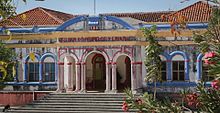Pinto Correia schools
The Pinto Correia Schools are seven school buildings that were built on behalf of Lieutenant Armando Eduardo Pinto Correia , the administrator of the Baucau military command (1928 to 1934) in what was then the colony of Portuguese Timor (now East Timor ). They originated in Teolale (part of the city of Baucau ), Laga , Haudere , Quelicai ( Afaçá , 8 ° 32 ′ 48.9 ″ S , 126 ° 36 ′ 13.4 ″ E ), Vemasse , Laivai and Venilale .
history
Up to this point there were only three moderate missionary schools in the military headquarters. These should be replaced by the new facilities. The buildings were financed by the local administration. They were built through voluntary work by the local population. All seven schools were built by Pinto Correia on the same principle. Each building had a foyer , an inner courtyard ( patio ), a classroom and a refectory . The School of the Empire of Venilale ( Portuguese Escola do Reino de Venilale ) is the largest of the buildings and follows the model of two pavilions with a simple, incised hipped roof made of corrugated zinc sheet. A third creates the connection between the two pavilions, in which the vestibule is located with the main entrance and which also leads to the patio. It is reminiscent of a monastery courtyard and has a circular wall. Inside there was a flower bed and a shade tree. In this way, a “U” was created from the three pavilions with a simple veranda on the galleries , which with their arcades form the arms of the letter. A gable crowns the main entrance with its three arcades in the center. The middle arch is raised, a pyramid-like staircase leads to the entrance with a platform at the top, in front of the entrance. The round gable and the double columns reveal a Chinese influence on the otherwise classical style of the front.
Pinto Correia was also responsible for the curriculum. The school building was the center of a network of facilities such as facilities for outdoor and indoor sports, workshops for wood and metal processing, a garden for teaching agriculture and accommodation for the teacher. This reflects the colonial way of thinking, according to which it was sufficient to teach the local population only the basics of reading and writing and to supplement this with practical training.
The Venilale school was renovated in 2005. Today it houses a computer room, a library, a playroom and a lounge. It and the secondary school of St. Anthony of Teolale are run by the Salesians of Don Bosco . The school in Vemasse and the school in Haudere, two kilometers from the town of Baguia , were badly damaged in the Second World War. While the school in Vemasse was being renovated, the one in Haudere fell into disrepair, so that today only the outer walls remain. Even the Laivai school in Ililai is now only a ruin.
The Quelicai school in Afaçá, built in 1932, was partially destroyed in the Second World War and could no longer be used for teaching. After the Indonesian invasion , the building served as a barracks for the occupiers, which led to further destruction. In the early 1980s, only the outer walls of the school were left. Since 2014 the ruins have been used again as a secondary school under the name Escola D. Carlos Filipe Ximenes Belo , as there is no money for a new building. The classrooms were covered with zinc sheets, bamboo and palm leaves. Since 2018, a support association has been trying to collect 400,000 US dollars for the renovation of the school.
See also
Web links
Individual evidence
- ↑ a b Heritage of Portuguese Influence Portal: The Pinto Correia Schools , August 9, 2012 , accessed August 21, 2015.
- ↑ Visit Venilale: Things to see , accessed on August 21, 2015.
- ^ Image from Laivai on Facebook , accessed October 23, 2017.
- ^ Image from Quelicai on Facebook , accessed July 17, 2016.
- ↑ Ponto Final Macau: Associação procura fundos para reabilitar escola em Timor-Leste , January 17, 2020 , accessed on January 17, 2020.




